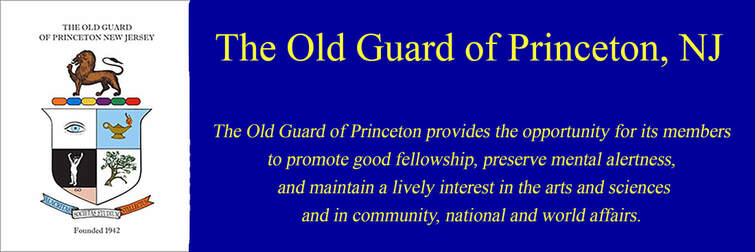March 9, 2011
The History of the Discovery
of the Cancer Drug Alimta
Edward C. Taylor
A. Barton Hepburn Professor of Chemistry Emeritus,
Princeton University
Minutes of the 21st Meeting of the 69th Year
On Mar. 9, 2011, the twenty first meeting of the 69th year was called to order by Pres. Bob Varrin. Attendance was reported as 103. Bob Williams introduced a guest, Virginia
Reynolds, and Lynn Livingston introduced her guest, Charles Westhoff. Carl Brown presented the minutes.
Scott McVay introduced last week's guest speaker: Edward (Ted) Taylor, "Prof. of Organic Cancer Emeritus and Senior Research Scientist" at Princeton. Prof Taylor's
professional accomplishments are many. They include a number of international & domestic academic appointments and positions, along with his productive career
starting at the Univ. of Illinois in 1951 before moving to Princeton in 1954. He has authored more than 450 scientific papers and has 52 U.S. patents.
Prof. Taylor's subject was "The History of the Discovery of the cancer drug Alimta". It relates the project on which he had pursued the cooperation between industry &
academia that ultimately led to the development of an important new drug.
It began, for Ted Taylor that is, with his choice of a graduate topic at Cornell. He had read an academic journal article describing a new compound that tempered the
growth of bacteria. It had struck him that its pigment had a yellowish-orange color identical to substance of the inside wing of a butterfly that had the property to kill
bacteria. A connection was spawned to his awareness of a compound at Lederly that had a like structure, was a potent anti-bacterial agent, and later became known as
Folic Acid, an item required for every form of life on earth.
By now, in the 1950's, Lederly and others were recognizing the value of folic acid bacteria-killing properties and Prof. Taylor was familiar with their attempts to harness
and control them. But Lederly had had problems in their work and in 1984 he sent his protocol to the Eli Lilly Co. in Indianapolis. The major challenge was to modify the
compound for selectivity in its bacteria-killing, to kill the targets "but not the chicken", of course an immensely complex task when safety is paramount. Early compounds
tested were too expensive to ever produce a product at a realistic cost. Progress on the project was slow.
But as it can in fiction, a totally surprising discovery occurred. Vitamins, normal vitamins, entered the scene. The addition of Vitamin 6-12 to the formulation turned out to successfully temper the impact of the folic acid while maintaining the integrity and safety of the product. A drug for lung cancer had been developed!! It is not a cure.
Nothing is as yet in this challenging category. But Alimta is now helping lung cancer patients to live longer!
In its success, it was a unique model, a new product for the drug company, and for Princeton, royalties that I understand have built the new chemical building. It will be
dedicated this year. Congratulations to Prof. Emeritus Ted Taylor!
Respectfully,
Jim Johnson
Reynolds, and Lynn Livingston introduced her guest, Charles Westhoff. Carl Brown presented the minutes.
Scott McVay introduced last week's guest speaker: Edward (Ted) Taylor, "Prof. of Organic Cancer Emeritus and Senior Research Scientist" at Princeton. Prof Taylor's
professional accomplishments are many. They include a number of international & domestic academic appointments and positions, along with his productive career
starting at the Univ. of Illinois in 1951 before moving to Princeton in 1954. He has authored more than 450 scientific papers and has 52 U.S. patents.
Prof. Taylor's subject was "The History of the Discovery of the cancer drug Alimta". It relates the project on which he had pursued the cooperation between industry &
academia that ultimately led to the development of an important new drug.
It began, for Ted Taylor that is, with his choice of a graduate topic at Cornell. He had read an academic journal article describing a new compound that tempered the
growth of bacteria. It had struck him that its pigment had a yellowish-orange color identical to substance of the inside wing of a butterfly that had the property to kill
bacteria. A connection was spawned to his awareness of a compound at Lederly that had a like structure, was a potent anti-bacterial agent, and later became known as
Folic Acid, an item required for every form of life on earth.
By now, in the 1950's, Lederly and others were recognizing the value of folic acid bacteria-killing properties and Prof. Taylor was familiar with their attempts to harness
and control them. But Lederly had had problems in their work and in 1984 he sent his protocol to the Eli Lilly Co. in Indianapolis. The major challenge was to modify the
compound for selectivity in its bacteria-killing, to kill the targets "but not the chicken", of course an immensely complex task when safety is paramount. Early compounds
tested were too expensive to ever produce a product at a realistic cost. Progress on the project was slow.
But as it can in fiction, a totally surprising discovery occurred. Vitamins, normal vitamins, entered the scene. The addition of Vitamin 6-12 to the formulation turned out to successfully temper the impact of the folic acid while maintaining the integrity and safety of the product. A drug for lung cancer had been developed!! It is not a cure.
Nothing is as yet in this challenging category. But Alimta is now helping lung cancer patients to live longer!
In its success, it was a unique model, a new product for the drug company, and for Princeton, royalties that I understand have built the new chemical building. It will be
dedicated this year. Congratulations to Prof. Emeritus Ted Taylor!
Respectfully,
Jim Johnson
